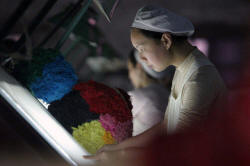|
Asian factories get off
to solid start in second quarter
 Send a link to a friend
Send a link to a friend
 [May 02, 2017]
By Rajesh Kumar Singh [May 02, 2017]
By Rajesh Kumar Singh
NEW
DELHI (Reuters) - Factories across much of Asia got off to a solid start
in the second quarter, buoyed by strong global demand, particularly for
hi-tech gadgets which are leading a sizzling rally in electronics.
Though China's manufacturing growth eased more than expected in April,
business still improved and there were no hints of a sharp loss of
momentum despite risks from a growing regulatory crackdown and fresh
measures to cool its heated housing market.
Indeed, analysts chalked up much of the softening in China to recent
falls in commodities prices, noting its official factory activity gauge
at the weekend was still not far from a near five-year high.
Globally, continued strength in Asia and expectations for upbeat PMI
readings from Europe later on Tuesday could help offset a recent soft
patch in the U.S. economy, though many economists believe that weakness
will be temporary.
"We expect global growth to pick up in the second quarter," said Krystal
Tan, Asia economist at Capital Economics in Singapore.

"Firmer global growth will lend strength to the ongoing recovery in
Asian manufacturing."
After six years of disappointing growth, the world economy is gaining
momentum, fueled by a cyclical recovery in manufacturing and buoyant
financial markets.
A multi-year trade recession for Asia's exporters has ended as global
demand revives, though the outlook is still being clouded by worries
about growing U.S. protectionism as the new Trump administration flexes
its muscles.
The spring in the air prompted the International Monetary Fund last
month to bump up its 2017 global growth forecast to 3.5 percent from 3.4
percent in January.
The Asian factory surveys pointed to subsiding inflationary pressures as
well as continued economic recovery, giving the region's central banks
scope to keep policy on hold as they wait for the U.S. Federal Reserve's
next move. It is expected to raise rates again next month.
Australia's central bank held rates steady for a ninth straight month on
Tuesday as it sought to balance the risk of busting a property bubble
against sluggish wage growth. Its next move is expected to be a rate
rise next year.
Even China has started gingerly tightening policy and clamping down on
some types of financing to contain the risks from years of debt-fueled
stimulus, though analysts expect policymakers to move cautiously to
avoid hurting growth and rocking the boat ahead of a major leadership
transition later this year.
President Xi Jinping made a rare speech last week on financial
stability, calling for increased efforts to ward off systemic risks.

GRADUAL SLOWING SEEN FOR CHINA
While the expansions in China's factory and service sectors slowed more
than expected, analysts were not alarmed, noting that economic growth
had been expected to slowly moderate after a surprisingly strong start
to the year.
Betty Wang, senior China economist at ANZ, said some loss of steam in
the monthly surveys does not portend a growing risk of a hard landing,
noting the government remains supportive of ample credit for the real
economy despite a crackdown in certain sectors such as real estate,
riskier forms of short-term lending and shadow banking.
[to top of second column] |

A woman works at a textile factory in Xiangfan, Hubei province,
China December 31, 2005. REUTERS/Stringer/File Photo

China's official Purchasing Managers' Index (PMI) released at the
weekend fell to a six-month low of 51.2 in April from 51.8 in March,
but pointed to expansion in the factory sector for the ninth
straight month.
The China Caixin/Markit PMI on Tuesday (PMI) fell to 50.3 from
March's 51.2. The Caixin survey focuses more on small and mid-sized
firms, which have been under more stress than their larger,
state-owned peers.
Economists largely attributed the softening in both surveys to
weaker prices for iron ore and other industrial commodities and to
signs of moderation in China's housing market after a flurry of
steps to curb speculation.
Wang at ANZ said many companies had "too strong" a bullish view when
global commodity prices began rallying late last year, but said that
trend is now changing, making firms more cautious about spending.
ELECTRONICS EXPORTS
Growth in electronics exports has been one of the highlights of
Asia's export recovery this year, boosting profits for companies
tied into supply chains such as Apple Inc's, which is gearing up for
the launch of the iPhone 8 later this year.
China, Japan, South Korea, Taiwan and Singapore have all reported
stronger shipments in recent months, often led by electronics. South
Korea on Monday reported April exports rose 24.2 percent on-year,
the fastest since August 2011.
Global stock market investors are also cashing in on the so-called
electronics "super-cycle".

Samsung Electronics <005930.KS> gained as much as 2.0 percent on
Tuesday, helping to lift the country's Kospi index <.KS11> to within
reach of its all-time high marked in 2011.
Taiwan Semiconductor Manufacturing Co (TSMC) <2330.TW> hit a record
high, rising as much as 2.3 percent.
In other parts of Asia, manufacturing activity hit a 10-month high
in Indonesia and expanded for the first time in two years in
Malaysia.
In India, the activity expanded for a fourth consecutive month in
April, helped by stronger growth in new orders.
Japan's manufacturing also expanded at a stronger pace last month,
according to a revised survey on Monday.
(Reporting by Rajesh Kumar Singh; Editing by Kim Coghill)
[© 2017 Thomson Reuters. All rights
reserved.] Copyright 2017 Reuters. All rights reserved. This material may not be published,
broadcast, rewritten or redistributed. |